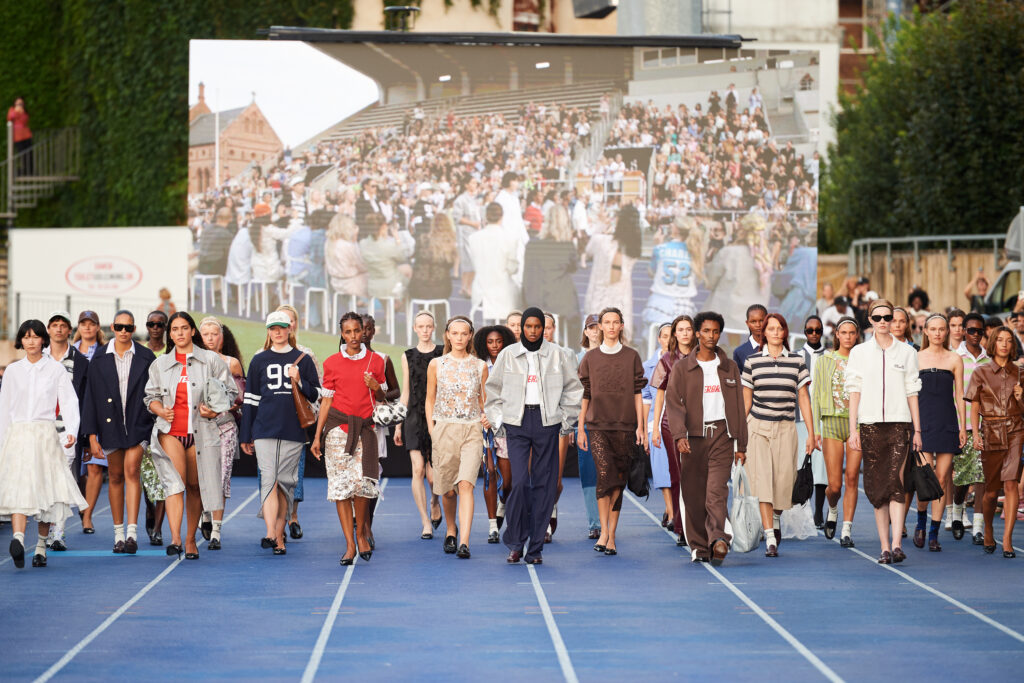Looking to Spring/Summer 2025 with a More Sustainable Lens


With covetable Scandi street style, (almost) uninterrupted sunshine, a stream of celebrations, and bikes aplenty, it is easy to understand the hype around Copenhagen Fashion Week (CPHFW) i.e. fashion’s unofficial ‘fifth’ major fashion week. This month saw the fashion set descend on the Danish capital for a week that can only be described as somewhat slower than that of the traditional ‘big four’ (New York, London, Milan, and Paris) with a set of stringent sustainability requirements defining all shows and presentations and an approachable and progressive atmosphere. This powerful Scandinavian hub is flipping the script on the traditional fashion week while maintaining the joy and creativity that draws people to fashion in the first place. Despite its comparatively modest size for a fashion week, its comprehensive standards and bold actions are certainly no small feat.
The Sustainability Action Plan, introduced in 2020, once again set the tone for the season, with all brands adhering to the 18 mandatory sustainability requirements. Next season, these parameters are set to become even more rigorous with two new standards being introduced and others being updated. For example, the use of certified, preferred, next-gen, upcycled, recycled or deadstock materials within brand collections will need to account for 60% as opposed to 50%. Since the January edition of CPHFW it has been promising to see that Berlin Fashion Week has followed suit with its own set of sustainability requirements in partnership with CPHFW, yet it is undeniable that similar requirements need to radiate ever further afield for an industry shift, particularly to the aforementioned ‘big four’ fashion weeks.
Today, we break down the highlight themes from the Global Fashion Agenda team.
Copenhagen is a leader for inclusivity on the runway, but no one is doing it quite like Sinead O’Dwyer. For her first show in Copenhagen, as the recipient of the Zalando Visionary award, O’Dwyer collaborated with the Hair and Care Foundation and provided an immersive experience for guests affected by blindness and low-vision through audio descriptions and tactile fabric swatches. Her show also included the activist who is affected by blindness, Lucy Edwards, with her guide dog, setting new benchmarks for inclusivity in fashion. Shows such as Herskind and Fine Chaos also featured models with disabilities.
On the first day, Alectra Rothschild, the first openly transgender woman to show at CPHFW, hosted a community casting centred around the queer community. The latest Alectra Rothschild / Masculina show was a powerful demonstration of representation.

The emphasis this season on traditional skills, combined with modern pioneering practices, highlighted how fashion can honour its roots while pushing forward into a more responsible future.
Stem’s intimate showcase presented a collection which used its signature zero-waste knitwear production technique, wherein no fabric is produced before the final design is made. At the presentation, designer Sarah Brunnhuber announced her plan to revive weaving in Denmark by founding a small Stem mill which can be utilised by other brands too.
Finnish Menswear Designer Rolf Ekroth presented a collection featuring handcrafted, sustainable, and upcycled materials. Last season, his handknits, made with Finnish yarn manufacturer Novita, were made available as patterns and yarn kits for home knitters. This season, a pair of Macramé crafted blue denim jeans crafted with 250 dandelions were a highlight.
Joao Maraschin focuses on meaningful handmade collections, speaking to the GFA team backstage he shared: “Sustainability for me is completely non-negotiable and it has always been with the DNA of the brand from the outset.” His latest ‘Road Trip’ collection incorporated denim from TENCEL biodegradable fibres in collaboration with Canatiba Textil and included wool pullovers, crafted by artisans from Minas Gerais in Brazil using materials by Círculo, some of which were printed with biodegradable resin in London.

One of the overarching sustainability themes of the week was the use of upcycled, recycled, and deadstock materials.
Kicking off the shows, OpéraSPORT made a statement with a waterside runway emphasising modern romanticism through a blend of undone ruffles and athleisure, with the collection comprising of at least 80% recycled textiles.
Sól Hansdóttir’s immersive showcase, ‘Simulation Swan’, focused on intricate, colourful knits made entirely from deadstock materials sourced from the Red Cross and a London supplier.
(di)vision, renowned for its upcycled and reconstructed materials, hosted a buzzy show to present its latest collection which was 95% upcycled – including the much-discussed teddy bear coat – which made for an immersive experience that blended fashion with sustainability.
For cult Danish brand Baum und Pferdgarten’s ‘Office Olympics’ show – Over 50% of the fibres came from recycled, organic, or environmentally certified origins.
Jade Cropper added another element to the sustainability conversation with multi-functional and transformable garments, for example, a jacket and skirt that can be converted into bags and a dress that can be transformed into a skirt and coat. Handcrafted in Jade Cropper’s studio in Stockholm, each garment is made using deadstock, recycled, or waste fabric.

Despite the remarkable strides made by Copenhagen, fashion weeks ultimately centre around commercialism and consumption and the sustainability standards are not necessarily a silver bullet to ensure holistic sustainability (this is a notoriously tricky and much debated metric to pin down industry-wide). The Sustainable Fashion Communication Playbook from the UN Environment Programme highlights the importance of the fashion sector’s ‘brainprint’—its influence on consumption patterns beyond its footprint. Runway shows significantly impact this cycle, inspiring collections from brands that may not adhere to such rigorous sustainability standards.
However, showcasing more responsible fashion without compromising creativity is crucial for industry transformation. The actions of Copenhagen Fashion Week serve as a powerful case study, demonstrating that more sustainable fashion could be achievable and lead to vibrant, innovative, and inclusive design. We hope that this influential Scandinavian country’s efforts will inspire similar approaches worldwide, driving the fashion industry toward a more sustainable future.